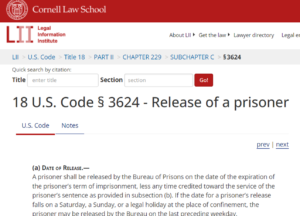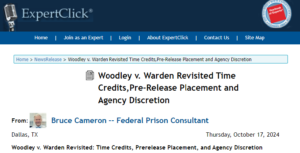YOU WERE PREPARED, EARNING YOUR ETC – STILL
YOU’RE NOT RELEASED TO HH or HC – FRUSTRATION IS EXPECTED; THERE’S 1000’S LIKE YOU
A
DON’T LET ANGER WIN – THIS IS STILL THE BOP’S WORLD
The BOP Has Options – But Nothing Yet
18 U.S. Code § 3624(g)(2) – Policy to Release Prisoners
(3)Types.—A Prisoner could be placed in one of these three prerelease options as follows:
(B)Residential reentry center. Limited bed space is not the inmate’s fault. Every year, the Second Chance Act Community-based Financial Assistance provides funding expressly for brick-and-mortar locations and staffing to visit those in home confinement. Per the NBC (6/1/2024) article, LISA Legal (6/4/2024) said that the BOP had 144 halfway houses, 10,000+ beds, and 8,200+ prisoners. They admitted they had a poor tracking system, so these numbers aren’t guaranteed.
(C)Supervised release.— This, too, is available for the BOP at their discretion. Suppose the sentencing court has included a requirement for the prisoner to serve a term of supervised release after their imprisonment, as outlined in section 3583. In that case, the Director of the Bureau of Prisons may transfer the prisoner to begin this supervised release up to 12 months earlier than scheduled. This transfer can be based on applying time credits under section 3632.
Writing numerous articles in Forbes, Walter Pavlo
- Due to limitations in halfway house capacity, inmates are staying in prison longer than necessary,
- FSA’s purpose was to reduce costs
- The BOP knew five years ago that halfway house space would be an issue
- Federal Location Monitoring (FLM) allows some home confinement prisoners to be monitored by Probation, which is less expensive and requires agreements with each of the 94-odd federal judicial districts.
Bruce Cameron, Writing in ExpertClick Woodley v. Warden Revisited
- Bruce Cameron and retired BOP Unit Management Section Chief Susan M. Giddings state that the Bureau of Prisons (BOP) is required to allow transfer to prerelease custody without discretion, including lack of available physical space. However, the agency has discretion over the transfer type and location. The BOP can decide whether to transfer the petitioner to a halfway house, place them under home confinement, or grant an early supervised release.
- Additionally, the court does not require that a petitioner be assigned to a specific halfway house; instead, the Bureau of Prisons (BOP) can select the prerelease facility. This situation undermines the primary goal of reentry as established by Congress in the First Step Act, and it contradicts the aims of the Second Chance Act.
- The Bureau of Prisons (BOP) states that inmates with First Step Act (FSA) credits can use them for halfway house or home confinement, but the decision is up to the facilities. The BOP must place inmates based on their Federal Time Credits (FTCs) rather than the facilities’ preferences. It contends that inmates lack certain constitutional rights concerning their confinement and have exclusive authority over where they serve their sentences. Ultimately, the BOP decides the appropriate facility for each inmate.
The Bureau of Prisons (BOP) rightly retains discretion over the type and location of placements for individuals. As highlighted by the Woodley court, “the BOP has the authority to decide if the petitioner will be transferred to a halfway house, home confinement, or even granted early supervised release.” Importantly, the court does not mandate a specific halfway house for the petitioner; thus, the BOP is empowered to choose the most suitable prerelease facility based on individual circumstances and needs. Judge Lungstrum.
- Congress failed to include an effective prerelease community program in the First Step Act (FSA), which is concerning given the significant impact of an incarcerated individual’s distance from home—whether 5 miles or 500 miles—upon transfer. Focusing solely on distance misses the core issue at hand.
- The primary objective should be to ensure a seamless transition for individuals returning to their communities after incarceration. This transition is crucial for allowing them to reconnect with family, friends, and support networks that are essential for successful reintegration. Proximity to home enables them to access local resources, seek employment opportunities, and engage in community activities that foster a sense of belonging.
Prioritizing these reentry aspects enhances the chances of successful rehabilitation and reduces the likelihood of recidivism. I wholeheartedly support Mr. Cameron’s perspective on the importance of community involvement in the prerelease process.
FSA Successes
- Ja’Ron Smith, former Deputy Assistant for Domestic Policy under Trump, noted that the recidivism rate for First Step releasees is about 37% lower than what it was before the Act passed, LISA Legal 6/22/24
- J. Charles Smith III, president of the National District Attorneys Assn, “said that the bad people who make bad decisions stay in jail… The good people who made a bad decision were convicted for it, [and] went to jail for it, are getting rehabilitated and released earlier as well, as they should.”
- Continuing the FSA’s success depends, in part, on resolving the nationwide staffing shortages (which will allow these staff to go back to doing the jobs they were hired to do), supporting those BOP staff who are working daily to make a difference, and addressing the multitude of other issues that plague federal agencies.
THE INABILITY OF THE BOP IMPLEMENTATION PROCESS:
- Auto-calculated Earned Time Credits (ETC), Still Incomplete
- Transition to a Halfway House, Home Confinement, or Supervised Release Appears to be an Impossible Option—and Going Nowhere Fast.
- “Conditional Placement Date” Appeared in the third quarter of 2024 and then disappeared.
- The Straw That Broke the Camel’s Back was when the a)FTC Conditional Placement Date, b)Second Chance Act (SCA) Conditional Placement Date, and c)Conditional Transition to the Community Dates were all released (on paper) and together just created the Perfect Storm among untrained staff (not having the training, support from upper management(?) or just being overwhelmed), causing the ripple down frustration that AICs (and their loved ones) were hit with.
Director Peters has made a tremendous effort to wrap her team around an agency that sometimes appears out of sync with her aspirations. Meanwhile, Congress has to fix the FSA and SCA Laws so that those who earn and deserve ETC and FTC do not have to fight their way through the courts, and Case Managers can spend their time working in peace. All that is left, among other issues, is for the BOP Staffing Shortages to be resolved.
ETC AND GOOD INTENTIONS DOSEN’T HELP AIC PLAN FOR A TIMELY RELEASE TO HH or HC
THE LACK OF TRANSPARENCY RESULTED IN
Did the BOP want to prove a point (?), as those 27 men found out at FPC Montgomery on 9/16/2024. When they decided to go on a food strike, the BOP sent them to a disciplinary housing unit at USP Atlanta (a Penitentiary, UGH!) as punishment for apparently, not eating in the mess hall and participating in civil disobedience.
BACK TO PRISON BASICS:-
This isn’t easy, but “fighting city hall” (Especially In Prison) ended up being a lose-lose, resulting in those 27 men being moved from a Free-Standing Minimum Camp to a Penitentiary. That is a life-altering change in anybody’s language.
ONLY YOU CAN CONTROL WHAT “YOU” DO AND HOW YOU “REACT.” CONTINUE TO LOG YOUR ETC PROGRESS AND DAILY ROUTINE.
USE THE ADMINISTRATIVE REMEDY PROCESS IF APPROPRIATE – TWO PARTS
PART I: FOR THE ADULT IN CUSTODY
PART II: FOR LOVED ONES ON THE OUTSIDE TO HELP WHERE THEY CAN
PREPARATION FOR THE DISAPPOINTMENT TO COME – BEGINS BEFORE YOUR PRESENTENCE INTERVIEW
Your Case Manager
- First, they’re employees, have supervisors, and with all of these changes, even if they have good intentions, they don’t know what to do without support and training.
- In addition, they face a line of inmates waiting each morning, ready to complain. Most have good reasons, which I will list below, but they didn’t create this problem.
This Won’t Solve The Problem,
- Consider arriving with a plan for a daily routine and an organized logbook or journal for documenting your daily work demonstrating personal development; you will stand out. This includes notes from your FSA Programs and what you’ve learned, non-fiction books read, or post-grad classes taken and what you’ve learned. Possibly, you have an idea to teach a class, reviewed the idea with your case manager, and was given the ok, great, just one more thing to include.
- Insurance. Consider that you have these policies to refer to at home, for home, health, auto, etc. If you will, this same logbook is your insurance for what you do each day. If you have a meeting with a correction officer and words were spoken, you’ve taken and attended an FSA class, and days to months later, you’re challenged, will you remember what happened? That logbook and its notes are your insurance, and this idea isn’t mine; it comes from those who have spent years inside – but I feel that it is and was a great idea.
D
D
D
ETC, FTC, AND THE BOP IS STILL LATE TO THE EVENT
- Better Late Than Never, BOP Comes To The FTC Party – Update for October 7, 2024
- Inmate FTCA Medical Complaints Don’t Need Expert Affidavits, Two Circuits Say – Update for November 11, 2019
- Former BOP Official Says “Wait Until The Halfway House Has Space” Is A Fable – Update for October 21, 2024
- You Can Slice a Cucumber, But Not a Federal Sentence – Update for October 16, 2024
- Thinking About a Report… And a Big White Bear – Update for July 15, 2024
- Private FSA Tool To Provide Prisoners Data the BOP Won’t – Update for March 4, 2024
- Detainers No Longer Disqualify Some FSA Credit Application – Update for February 13, 2023
- Here We Go Again On FSA Credits – Update for January 9, 2023







